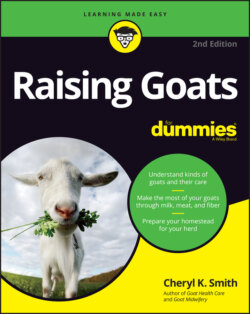Читать книгу Raising Goats For Dummies - Cheryl K. Smith - Страница 112
Removing poisonous plants
ОглавлениеGoats ignore poisonous plants most of the time, but because of their need to browse, they may try them just for variety. Whether goats that eat a poisonous plant show signs of poisoning depends on how much of the plant they eat, what part of it they eat, the condition of the plant (fresh or dried), the time of year, and the size and health of the goat. They may have no signs of poisoning, or they may get very sick and even die. Chapter 11 tells you how to identify signs of poisoning and what to do for a poisoned goat.
Some of the common poisonous plants that might grow in your pasture or backyard include:
WeedsBracken fernButtercupCommon milkweedFoxgloveLantanaLocoweedPoke weedSpurgeSt. John’s WortWater hemlock and poison hemlock
TreesCyanide-producing trees such as cherry, chokecherry, elderberry, and plum (especially the wilted leaves from these trees)Ponderosa pineYew
Cultivated plantsAzaleaKaleLily of the valleyOleanderPoppyPotatoRhododendronRhubarb
Many landscaping plants are poisonous, and a few are so deadly that even a few leaves can make your goat extremely sick. Don’t believe the old wives’ tale that goats always know what is poison or not. Before you bring your goats home, check your yard for these plants. The best resource for doing so is A Guide to Plant Poisoning of Animals in North America (Teton New Media), by Anthony P. Knight and Richard Walter. You can find many chapters of it online at the International Veterinary Information Service (www.ivis.org). I can provide only limited information here, and so I recommend you check out the website and the book to make sure you’re familiar with the poisonous plants in your area.
If your goats can get their heads through a fence to the neighbor’s yard, make sure that poisonous plants aren’t growing within reach there.
If you find any of these plants, either remove them or make sure that your fencing will keep your goats away. If the poison plant is a tree, make sure that the leaves won’t fall into the pen in the autumn by either removing the tree or situating the pen far from the tree. Dried leaves can be the most deadly part of the tree.
You usually don’t need to freak out if one of your goats eats a little taste of any of these plants or trees, but you do need to keep an eye on him in case he shows signs of sickness. (See Chapter 11 for more about poisons.) I had a rhododendron plant in my front yard for years, and when I let the goats out they sometimes took a little taste. I found it nerve-wracking and finally removed the plant, but none of my goats ever showed signs of poisoning.
I recommend that you talk to your neighbors about poisonous plants and ask them not to throw their garden trimmings into the yard as a treat for your goats without asking first. I lost a goat kid to oxalate poisoning from kale that a friendly neighbor had given my goats.
